#dm D&d
Text

This... this is a whole different kind of psychic damage here. When nightmares got Marcille, we get to knew that her's biggest fear is outliving her friends. This isn't even canon probably, but look at this. This isn't a "I don't want my friends to die" kind of dream. This is a "I'm terrified of loosing my daughters, of something killing them, and being incapable of stopping it" kind of dream. It's so simple yet it explains perfectly the whole of chilchucks character. He loves, he cares, deeply. But he, or doesn't acknowledges, or doesn't know what to do with that knowledge.
Besides that. Someone had to wake him up after this. Imagine the devastation in this man after he wakes up. He just saw his three little babys murdered corpses (or maybe he saw them die, wich isn't better). He would possibly not talk about it, and that would worry the hell out of the party, because we'll, they see him all down and only one of them knows what he saw. Imagine being the one to pull him from that nightmare. Seeing this man, usually so composed, fuking staring with tears and terror in his eyes to the composes of what you can only assume are his daughters. It would be heartwrenching.
Idk, I love this man so much...
#dungeon meshi#chilchuck#chilchuck tims#if someone wants to write a fic on this#@ me#PLEASE I WANT TO SEEEE#or dm me so i actually see it#please#if someone makes something of this post...#swnd me an ask with a link#this post exploded i cant with all the notifs#i wouldnt know if someone @'d me#i did a tags recap down on the notes and wrote a bit of#chilchuck angst#for the simps out there#my shit
8K notes
·
View notes
Text
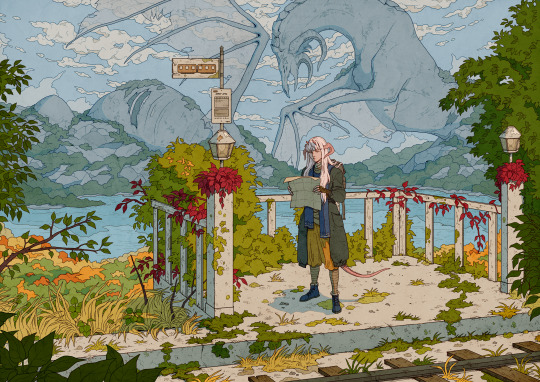
Traveller
#artists on tumblr#at it again with the detailed backgrounds#there's something so relaxing about drawing 49285947 leaves#it seems we've kind of skipped the colorful part of autumn here#went straight from summer hot days to winter depression grey#all of my DMs are on hiatus or travelling so no D&D for a couple of weeks#bless them all on their journeys and forays#i hope every DM is having a good day actually#thank u for your service
5K notes
·
View notes
Text
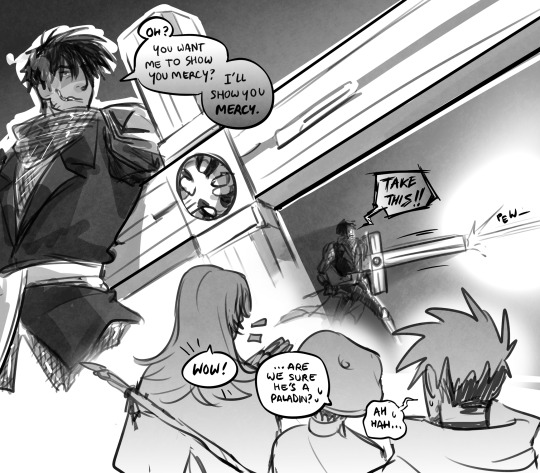


More Trigun DnD AU!
#nai is the dm of course#alexxuun#trigun#trigun stampede#trigun fanart#vash the stampede#nicholas d. wolfwood#meryl stryfe#milly thompson#trigun au#dnd au#trigun dnd au
1K notes
·
View notes
Text

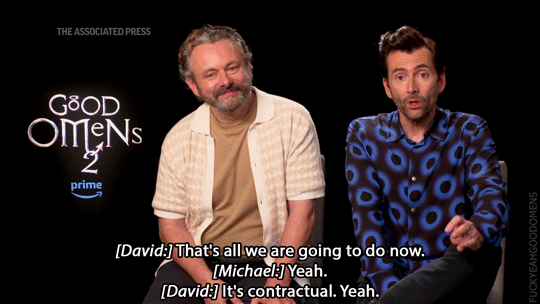

Question: And in the meantime, you were still working together. You were doing Staged. So do you guys just love to work together?
David: That's all we are going to do now.
Michael: Yeah.
David: It's contractual. Yeah.
Michael: Yeah. Neil Gaiman made us sign a contract in blood.
David: And that's it forever now.
Michael: Yeah.
#good omens#gointerviewedit#michael sheen#david tennant#david and michael#dm#associated press#interview#michael interview#david interview#david and michael interview#neil gaiman#associated press 2023#s2 interview#thank you neil? :D
1K notes
·
View notes
Text
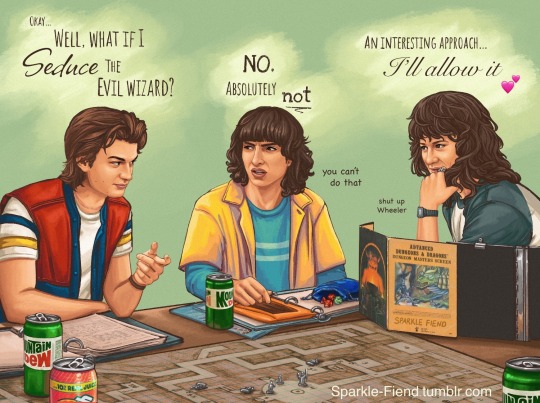
Steve plays D&D 1/2
(next up: Will, Dustin, and Lucas react)
#steddie#my art#eddie munson#steve harrington#mike wheeler#steve plays D&D#flirting is a perfectly acceptable tactic Steve#especially when the DM is so cute#don’t listen to Mike#stranger things fanart
6K notes
·
View notes
Text

dungeon yuri
#namari tade and falingon. all of them gauve me covid#i always play buff dwarf women in d&d so namari was awesome to see#IT WAS ALSO SO GOOD!!#im working on a DM marcille piece rn#dunmesh#dunmeshi#dungeon meshi#delicious in dungeon#dungeon meshi fanart#art#my art#falin touden#marcille donato#farcille#doodle
900 notes
·
View notes
Text
hey hey --
it's ya girl with another journalism request!!!
are you — or anyone you know — running a d&d campaign and have you noticed changes in your campaign dynamic after baldur’s gate 3 came out? do your players finally know how to use bonus actions and spell slots? i’d love to talk to you! please send me a DM here or email me at petrana at polygon dot com by friday (8/25)!!!
#bg3#baldur's gate 3#d&d#dungeons and dragons#ttrpg#journorequest#polygon#turning off reblogs since i have enough answers but ty for everyone who responded in DMs or the replies here or emailed me!!
1K notes
·
View notes
Text

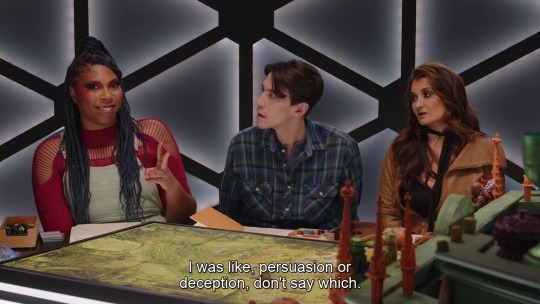

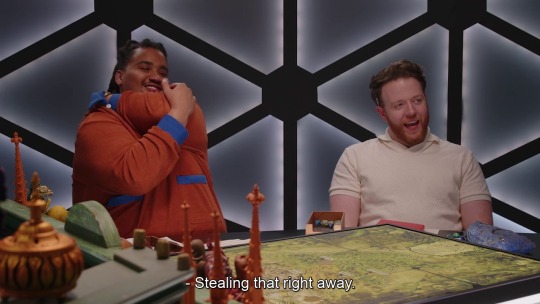


MATT: When I ask for persuasion or deception on your end, when someone's rolling insight on you, that's an opportunity for you to be honest and choose persuasion. That way, when the opportunity does arrive that you are deceiving somebody, the person that's rolling insight doesn't know whether you are or not.
AABRIA: I've taken that from you, by the way. I love that. I was like, persuasion or deception, don't say which.
MATT: Yeah, the player chooses, they just say a number, and then whether you're deceiving or you're not, if you succeed over them, then you get to give the information you want.
BRENNAN: That's slick as hell. And that's what I do now too. Stealing that right away.
MATT: We all steal from each other. Make us all better.
— Adventuring Party: All About The Ravening War S12E04: "The Mystic River Episode"
#Adventuring Party#dimension 20#The Ravening War#matthew mercer#brennan lee mulligan#aabria iyengar#how to rogue#d&d#5e#persuasion#deception#crunch#steal all the things#and especially DM tricks
2K notes
·
View notes
Text

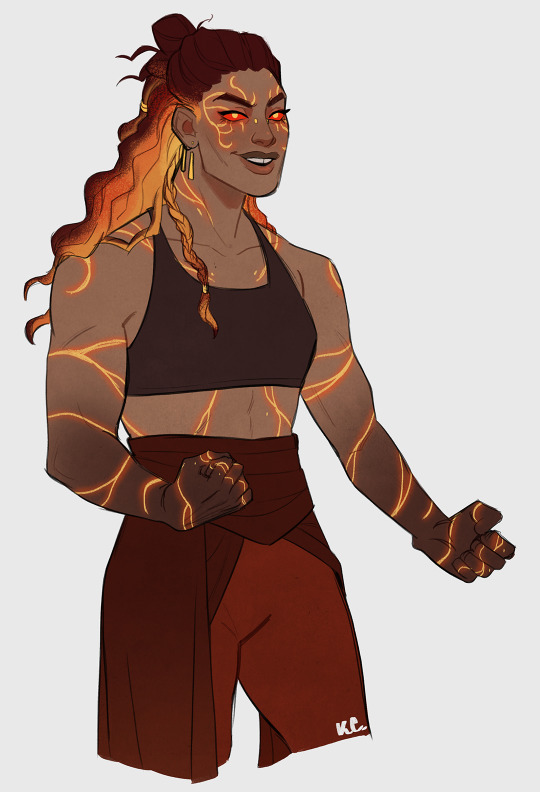
our next game is gunna be call of the netherdeep and I've decided to play ves! I settled on ascendant dragon as her subclass which means at level 3 she gets a breath weapon 😎
#dnd#d&d#dungeons and dragons#fire genasi#goliath#monk#dnd oc art#drawerings#ocs#vesuria sinterbrand#exandria#wildemount#our evil game was originally the plan but that dm had a baby so he's on hiatus for a bit lmao#c: netherdeep
587 notes
·
View notes
Text
In the early days of Eddie’s internet career when he was doing absolutely anything to starve off boredom during covid lockdown, he joins this virtual D&D campaign with some other celebrities. It’s live-streamed to raise money for covid relief.
He’s in the middle of the campaign when he hears a very, very flirty, “Wow, is that rockstar, Eddie Munson? I’m your number one fan.”
Eddie’s eyes flicker to someone off camera and then he says with so much regret, “Babe, I’m working.”
You can hear Steve sigh off-screen and the sound of him leaving the room. Then you can hear someone laugh on screen and Eddie mumbles, “Shut up, Jeff.”
#Eddie having to choose between his two loves: D&D and Steve when he’s in the mood#D&D won because when is he going to get another chance to have Tom Morello as his DM?#plus they’re in lockdown. the only thing to do is fool around#eddie munson tiktok saga#eddie munson#steve harrington
1K notes
·
View notes
Text
i think reframing 'writing a campaign' or 'writing a plot' as writing beats has dramatically changed the quality of my dming. for me personally, i work best when i have a world with pieces that would be moving (regardless of whether the players would be there but obviously, you put the players in the crosshairs to effect change) and plan each 2-4 sessions as its own small story and i've developed a method that really works for me that i use for oneshots, mini campaigns, and in arcs for longer games.
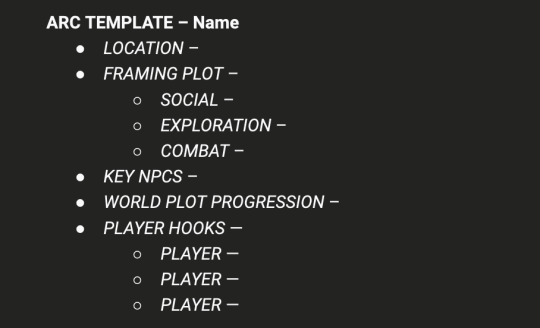
[ID: a screenshot of a bullet point list with template headers: Location, Framing Plot (subheaders Social, Exploration, and Combat), Key NPCS, World Plot Progression, Player Hooks (subheaders repeating Player to be replaced with a PC's name)]
to further explain:
Location(s) — where the sessions will likely take place, so I have a manageable list of places to develop further in terms of worldbuilding.
Framing Plot — What is happening, what is the inciting the incident and what are the things the players cannot control. Then the subheaders are the three tiers of play. I think it's important to have an idea to tap into all of them or lean heavier into what your party is interested in but consider all of them for fun and exciting Mechanical gameplay as well as story and roleplay.
Key NPCS — Who are the NPCS that are going to be important to the framing and to the players. This is usually just a handful.
World Plot Progression — How does / how will the events of this scenario push forward what your players are working towards?
Player Hooks — Specific thoughts for how to connect the framing plot to each player character and make each player feel invested and like their choices matter.
and that's what I do to plot out my games. It's never "this is how things will resolve" it is, "this is what the situation is and this is how i want to connect my players to it and see what they do"
#liza.txt#trying to do a better job w/ ids apologies if it's trash#my d&d posts#personal d&d tag#dm tag
5K notes
·
View notes
Text
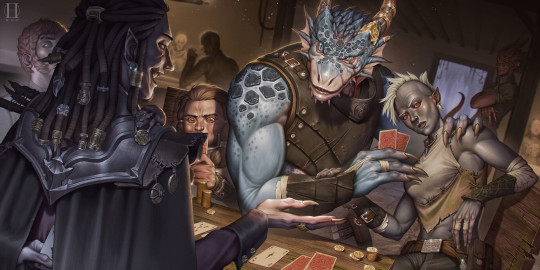
Dm Tip: Playing the Villain/ Guidelines for "Evil" Campaigns
I've never liked the idea of running an evil game, despite how often I've had people in my inbox asking how I'd go about it. I'm all about that zero-to-hero heroic fantasy not only because I'm a goodie twoshoes IRL but because the narrative-gameplay premise that d&d is built around falls apart if the party is a bunch of killhappy murder hobos. Not only would I get bored narrating such a game and indulging the sort of players who demands the freedom to kill and torture at will (I've had those before and they don't get invited back to my table), but the whole conceit of a party falls through when the obviously villainous player characters face their first real decision point and attempt to kill eachother because cooperation is a thing that goodguys do.
Then I realized I was going about it all wrong.
The problem was I had started out playing d&d with assholes, those "murder and torture" clowns who wanted to play grand-theft-auto in the worlds I'd created and ignore the story in favour of seeing how much unchallenged chaos they could create. They set my expectations for what an evil campaign was, and I spent the rest of my time developing as a dungeonmaster thinking " I Don't want any part of that"
But what would an evil campaign look like for my playgroup of emotionally healthy friends who understand character nuance? What would I need to change about the fundamental conceit of d&d adventures to refocus the game on the badguys while still following a similar enough narrative-gameplay premise to a hero game? How do we make that sort of game relatable? What sort of power/play fantasy can we indulge in without going off the deepend?
TLDR: In an evil campaign your players aren't playing the villains, they're the MINIONS, they're mooks, henchmen, goons, lackeys. They're the disposable underlings of uncaring overseers who have nothing but ill intent towards them and the world at large.
Where as in a hero game the party is given the freedom to challenge and overthrow corrupt systems, in an evil game the party is suck as part of that corrupt system, forced to bend and compromise and sacrifice in order to survive. The fantasy is one of escaping that corrupt system, of biding your time just long enough to find an opening, find the right leverage, then tossing a molitov behind you on the way out.
Fundamentally it's the fantasy of escaping a shitty job by bringing the whole company down and punching your asshole boss in the face for good measure.
Below the cut I'm going to get into more nuance about how to build these kinds of narratives, also feel free to check out my evil party tag for campaigns and adventures that fit with the theme.
Designing a campaign made to be played from the perspective of the badguys requires you to take a different angle on quest and narrative design. It’s not so simple as swapping out the traditionally good team for the traditionally bad team and vis versa, having your party cut through a dungeon filled with against angel worshiping holyfolk in place of demon worshipping cultists etc.
Instead, the primary villain of the first arc of the campaign should be your party’s boss. Not their direct overseer mind you, more CEO compared to the middle managers your party will be dealing with for the first leg of their journey. We should know a bit about that boss villain’s goals and a few hints at their motivation, enough for the party to understand that their actions are directly contributing to that inevitable doom.
“Gee, everyone knows lord Heldred swore revenge after being banished from the king’s council for dabbling in dark magic. I don’t know WHY he has us searching for these buried ancient tablets, but I bet it’s not good”
Next, you need a manager, someone who’s a part of the evil organization that the party directly interfaces with. The manager should have something over the party, whether it be threats of force, blackmail, economic dependency… anything that keeps the antiheroes on the manager’s leash. Whether you make your manager an obvious asshole or manipulative charmer, its important to maintain this power imbalance: The party arn’t going to be rewarded when the boss-villain’s plan goes off, the manager is, but the manager’s usefulness to the boss-villain is contingent on the work they’re getting the party to do. This tension puts us on a collison course to our first big narrative beat: do the party get tired of the manager’s abuse and run away? Do they kill the manager and get the attention of the upper ranks of the villainous organization? Do they work really hard at their jobs despite the obvious warning signs and outlive their usefulness? Do they upstage their manager and end up getting promoted, becoming rivals for the boss-villain’s favor?
Building this tension up and then seeing how it breaks makes for a great first arc, as it lets your party determine among themselves when enough is enough, and set their goals for what bettering the situation looks like.
As for designing those adventures, you’ll doubtlessly realize that since the party arn’t playing heroes you’ll need to change how the setup, conflict, and payoff work. They’re still protagonists, we want them to succeed after all, but we want to hammer home that they’re doing bad things without expecting them to jump directly to warcrimes.
Up to no good: The basic building block of any evil campaign, our party need to do something skullduggerous without alerting the authorities. This of course is going to be easier said than done, especially when the task spins out of control or proves far more daunting than first expected. The best the party can hope for is to make a distraction and then escape in the chaos, but it will very likely end with them being pursued in some manner (bounties, hunters, vengeful npcs and the like). Use this setup early in a campaign so you have an external force gunning for your party during the remainder of their adventures.
Dog eat dog: It’s sort of cheating to excuse your party’s villainous actions by having them go up against another villain who happens to be worse than they are. The trick is that we’re not going after this secondary group of outlaws because they’re bad, we’re doing it because they’ve either got something the boss wants, or they’re edging in on the boss’s turf. This sort of plotline sees the party disrupting or taking advantage of a rival’s operation, then taking over that operation and risking becoming just as villainous as that rival happened to be. This can also be combined with an “Up to no good” plot where both groups of miscreants need to step carefully without alerting an outside threat.
The lesser evil: This kind of plot sees your party sent out to deal with an antagonistic force that’s a threat not only to the boss’s plans but to everyone in general. In doing so they might end up fighting alongside some heroes, or accidentally doing good in the long run. This not only gives your party a taste of heroism, but gives them something in their back pocket that could be used to challenge the boss-villain in the future.
The double cross: In order to get what they want, the party need to “play along” with a traditional heroic narrative long enough to get their goal and then ditch. You have them play along specifically so they can get a taste of what life would be like if they weren't bastards, as well as to make friends with the NPCs inevitably going to betray. This is to make it hurt when you have the manager yank the leash and force the party to decide between finishing the job , or risk striking out on their own and playing hero in the short term while having just made a long term enemy. This is sort of plot is best used an adventure or two into the campaign, as the party will have already committed some villainous deeds that one good act can’t blot out.
Next, lets talk about the sort of scenarios you should be looking to avoid when writing an evil campaign:
Around the time I started playing d&d there was this trend of obtusely binary morality systems in videogames which claimed to offer choice but really only existed to let the player chose between the power fantasy of being traditionally virtuous or the power fantasy of being an edgy rebel. Early examples included:
Do you want to steal food from disaster victims? in Infamous
Do you as a space cop assault a reporter who’s being kind of annoying to you? in Mass Effect
Do you blow up an entire town of innocent people for the lols? in Fallout (no seriously check out hbomberguy’s teardowm on fallout 3’s morality system and how critics at the time ate it up)
I think these games, along with the generational backwash of 90s “edge” and 00s “grit” coloured a lot of people's expectations ( including mine) about what a "villain as protagonist" sort of narrative might look like. They're childish exaggerations, devoid of substance, made even worse by how blithely their narratives treat them.
Burn down an inn full of people is not a good quest objective for an evil party, because it forces the characters to reach cartoonish levels of villainy which dissociates them from their players. Force all the villagers into the inn so we can lock them inside and do our job uninterrupted lets the party be bad, but in a way that the players can see the reason behind it and stay synced up with their characters. The latter option also provides a great setup for when the party's actually monstrous overseer sets the inn on fire to get rid of any witnesses after the job is done. Now the party (and their players) are faced with a moral quandary, will they let themselves be accessories to a massacre or risk incurring their manager's wrath? Rather than jumping face first into cackling cruelty, these sorts of quandaries have them dance along the knife's edge between grim practicality and dangerous uncertainly; It brings the player and character closer together.
Finally, lets talk about ending the villain arc:
I don't think you can play a whole evil campaign. Both because the escalation required is narratively unsustainable, but also because the most interesting aspect of playing badguys is the breaking point. Just like heroes inevitably having doubts about whether or not they're doing the right thing, there's only so long that a group of antiheroes can go along KNOWING they're doing the wrong thing before they put their feet down and say "I'm out". I think you plan a evil campaign up until a specific "there's no coming back from this" storybeat, IE letting the Inn burn... whether or not the party allows it to happen, it's the lowest point the narrative will allow them to reach before they either fight back or allow themselves to be subsumed. If they rebel, you play out the rest of the arc dismantling the machine they helped to build, taking joy in its righteous destruction. If they keep going along, show them what they get for being cogs: inevitably betrayed, sacrificed, or used as canon fodder when the real heroes step in to do their jobs for them.
Art
#dm tip#dm tips#writing advice#evil party#drafting the adventure#dnd#d&d#dungeons and dragons#blades in the dark#ttprg#pathfinder
412 notes
·
View notes
Text
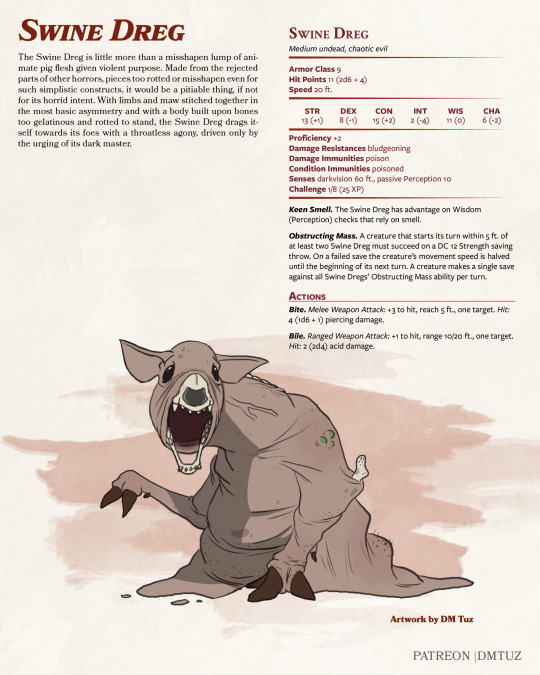
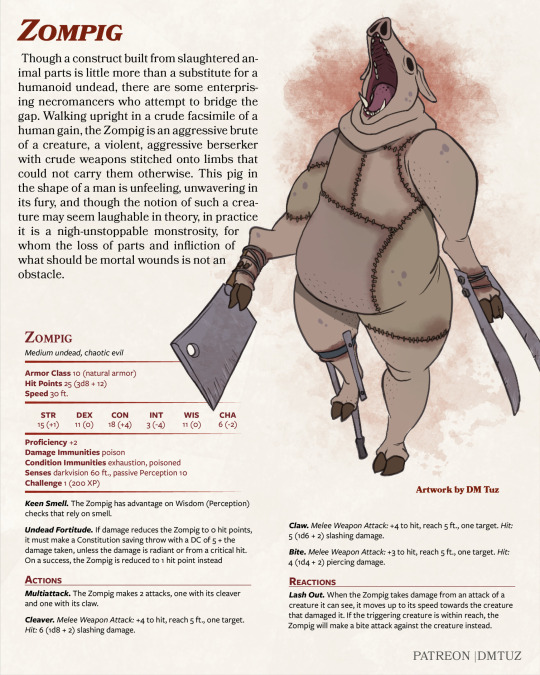




I am going back through my archives to post and collect content that I might have missed. Indeed I never posted a compilation of my remastered Slaughterhouse Horrors here. So here you go.
You can find the full PDF for free on my patreon!
Check out patreon[dot]com/dmtuz for more content!
571 notes
·
View notes
Text
Curated Spotify playlists to liven up your D&D sessions!
I have always loved playing D&D with background music that fits the location, mood, or type of combat, so I created several playlists on Spotify. This project is something I've been working on since December 2019, and something I want to share with you all! You can find the list below.
If you have suggestions for songs/tracks to include, or if you want a specific playlist that is not in this list yet, please let me know! And most of all, have fun!
Locations
Astral Plane
Ball/Masquerade
Bazaar
Castle/Court
City
Desert
Dungeon
Festival
Forest
Jungle
Monastery
Mountains
Schools of the Arcane
Ship
Tavern
Temple
Town/Village
Underwater
Moods
Creepy/Eerie
Dramatic
Enchanted
Energetic/Adventurous
Heroic
Grand
Intrigue
Menacing
Mysterious
Night
Peaceful
Sad/Mourning
Silly
Tender/Emotional
Combat
Small Battle
Big Battle
Boss Battle
Tavern Brawl
Chase
Themes/settings
Ancient Greece
Bard songs
Patrons/Visions
Visions/Dreams
#dnd#dnd 5e#ttrpg#music#spotify#playlist#writing#writing inspiration#spotify playlist#d&d#dungeons and dragons#worldbuilding#dm tools#resources#reference
1K notes
·
View notes
Text

Vista, @artist-rat 's character for my ttrpg campaign Llehia 🍂
#Llehia campaign#character sheet#c: Vista#ttrpg#dnd#D&D#dungeons and dragons#they have two lovers and as a DM I took both of them hostage#for motivation#now they are on a guest to get them back and get revenge#artificer#believe or not they just live in the vague bronze/iron age#story: Llehia
698 notes
·
View notes
Text
Every time I look at how to create a world for a campaign or just plan a campaign on the internet you usually get : start small with the town and maybe the few places around, you don't need to know everything about the world to start the campaign.
However what if your players want to create characters that come from beyond that place. You'll need to tell them what the world is like, what others kingdoms and lands there are and what is happening in there for them to be able to put their character in there and know what is going on so they have some guidelines about the world's alliances etc ?
How do you do ? (Also if I'm looking at it wrong please tell me I am but an aspiring DM)
395 notes
·
View notes